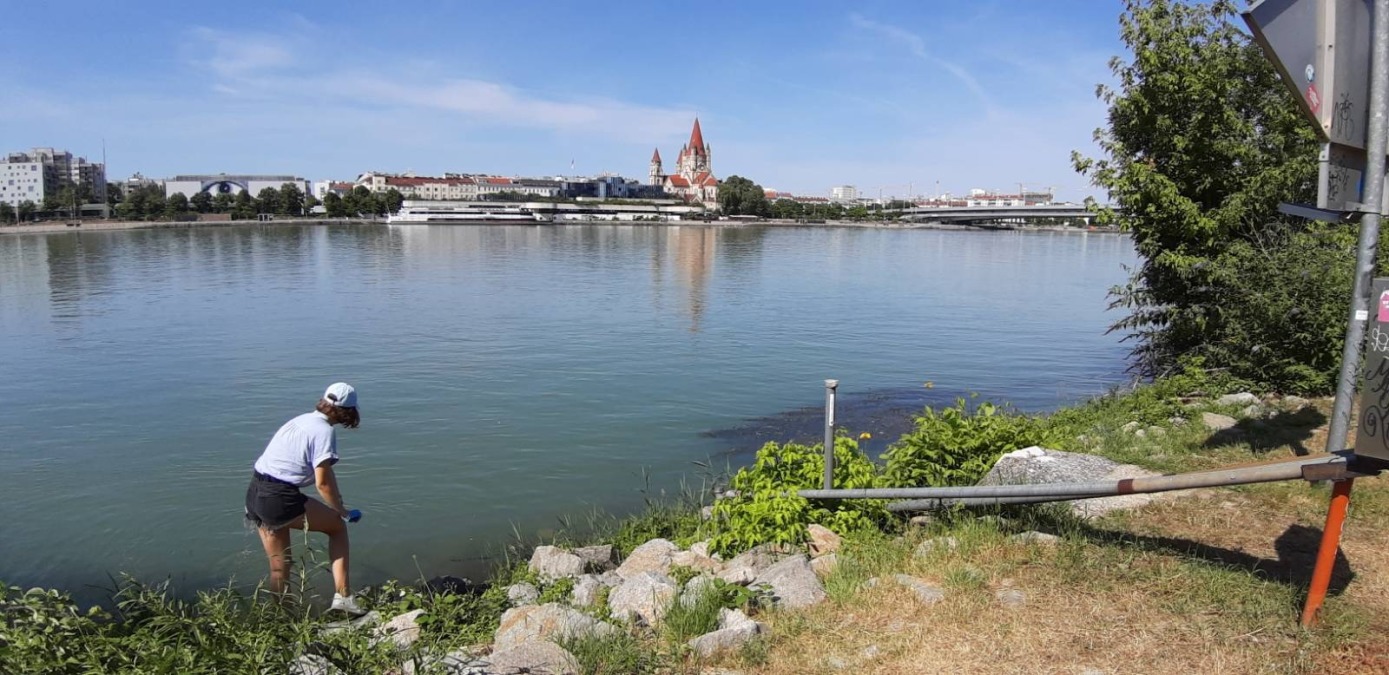TU Wien: Monitoring of PFAS at River Bank Filtration sites in Vienna and Budapest
One of the most important transport routes of PFAS to drinking water is through riverbank filtration (RBF). Although this is usually an effective strategy for removing many organic compounds, its effectiveness in removing PFAS is still unknown. The aim of TU Wien and other partners in Case Study 2 is to improve this knowledge to secure the safety of drinking water.

Sampling of the Danube surface water at the Danube Island near the Vienna RBF Transect. @Julia Derx
TU Wien started by setting up a monitoring campaign in both Vienna and Budapest, at four transects with different characteristics along the Danube River. Both campaigns ran for one year and were located on islands in the Danube, which are used for the extraction of drinking water. The aim of this study was to investigate the occurrence, as well as the spatial distribution of PFAS at RBF sites and compare these to two pharmaceuticals and various chemical parameters.
Samples were analysed using Liquid Chromatography Mass Spectrometry. Results show that most PFAS compounds had concentrations lower than 10ng/l. Of all measured PFAS, NaADONA had the highest concentration at each of the four sites, indicating the presence of an emission source upstream of the monitored sites.
For most compounds, there was no concentration reduction between the river and groundwater, implying that no removal processes take place. This was further confirmed with statistical tests, which showed no significant differences between river- and groundwater concentrations.
Two sites in Budapest showed higher concentrations of PFOA, PFOS, and GenX in the background water compared to the river, indicating an inland source of these compounds. This is the subject of further research, which includes modelling of the transport of these compounds in these transects, using a combination of MODFlow and PhreeqC to simulate the reactive transport through the subsurface. This is done in close collaboration with Deltares and will lead to the establishment of a model train from a large scale to smaller scales and finer resolution.
The current situation imposes no problems for drinking water as the measured concentrations are lower than the legal limit set by the EU Drinking Water Directive. However, any future legal or industrial changes could create problems since results suggest that these compounds are not removed during riverbank filtration. More can be read in Obeid et al., 2023: “The occurrence and persistence of PFAS at riverbank filtration sites in the Upper Danube basin.”
Column experiments for the PFAS transport
To further investigate the transport of PFAS substances through porous media, injection-extraction experiments were carried out in columns. These columns were 50 cm long and filled with lab-grade quartz sand. An injection solution containing 10 PFAS of different chain lengths and functional groups was pumped through the column at a flow rate similar to the field site, to study the sorption of these PFAS to the porous media.
After this injection, PFAS-free water was flushed through the column to investigate the desorption (or re-entrainment) of these substances in the water. This gave a more detailed picture of how these substances behave during transport, revealing that different PFAS groups exhibit varying orders of magnitude of sorption. Some behaved conservatively (no sorption), while others were entirely retained (complete sorption), and other had a behaviour somewhere in between these extremes.
The goal of TU Wien is now to figure out why these differences exist. Until now, they have found that in addition to functional groups and chain length, hydrophobicity played a crucial role in PFAS transport behavior. To investigate this further, simulations are being worked on with different sorption modules in Hydrus 1D. Preliminary results show that substances with higher sorption levels required more complex sorption terms and could not be accurately simulated by assuming equilibrium sorption.
 - Photo by Thomas Oudega.jpg)
Ali Obeid working on the PFAS column experiments in the groundwater laboratory of TU Wien (water flows from right to left). @Thomas Oudega
Multiple publications are planned with these results. However, the column tests are still being worked on, and more will follow using the natural soil taken from the field sites to study the differences between pure quartz sand and soils TU Wien finds in the environment.
